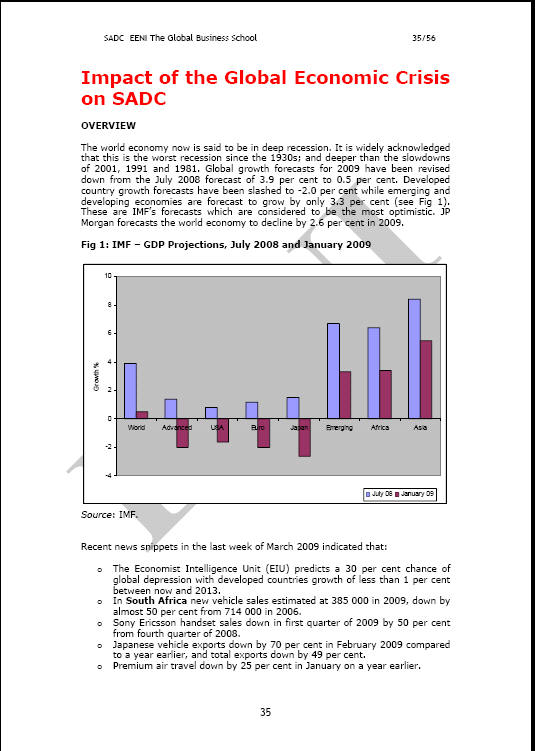
The leaders of the Southern African Development Community, the Common Market for Eastern and Southern Africa, and the East African Community signed an agreement in South African to develop a joint free trade bloc to stretch from Cape Town to Cairo, to encompass 26 countries
http://af.reuters.com/article/investingNews/idAFJOE75B05220110612
June 12 (Bloomberg) -- The leaders of three African regional economic blocs signed an agreement to develop a free trade zone stretching from Cape Town to Cairo.
The so-called Grand Free Trade Area would encompasses 26 countries, 600 million people and have an estimated gross domestic product of about $1 trillion, according to a statement released after a conference in Johannesburg today.
“The establishment of a Tripartite Free Trade Area will bolster intra-regional trade by creating a wider market, increase investment flows, enhance competitiveness and develop cross-regional infrastructure,” according to the statement.

The meeting was attended by leaders from the Southern African Development Community, the Common Market for Eastern and Southern Africa, and the East African Community. It is their second since an initial summit in October 2008. They agreed to further negotiations, without publishing any timeframes.
South African President Jacob Zuma told a press conference that Africa needs to remove hurdles to the movement of goods across boundaries and that infrastructure development must lift intra-Africa trade “from the current low base of 10 percent.”

South Africa, the continent’s largest economy, is driving regional integration as it seeks to create a larger market for companies such as Shoprite Holdings Ltd., Africa’s biggest retailer. Africa’s economy has grown an average of 5.7 percent each year over the past decade, according to the International Monetary Fund, fueling the expansion of a new middle class.
--Editors: Philip Sanders, Marthe Fourcade
To contact the reporter on this story: Sikonathi Mantshantsha in Johannesburg at smantshantsh@bloomberg.net.
To contact the editor responsible for this story: Philip Sanders at psanders@bloomberg.net
EAC
The East African Community (EAC) is an intergovernmental organisation comprising the five east African countries Burundi, Kenya, Rwanda, Tanzania, and Uganda.
The EAC is a potential precursor to the establishment of the East African Federation, a proposed federation of its five members into a single state. In 2010, the EAC launched its own common market for goods, labour and capital within the region, with the goal of a common currency by 2012 and full political federation in 2015.
* Kenya (2001)
* Uganda (2001)
* Tanzania (2001)
* Burundi (2007)
* Rwanda (2007)
COMESA
The Common Market for Eastern and Southern Africa, is a free trade area with nineteen member states stretching from Libya to Zimbabwe. COMESA formed in December 1994, replacing a Preferential Trade Area which had existed since 1981. Nine of the member states formed a free trade area in 2000 (Djibouti, Egypt, Kenya, Madagascar, Malawi, Mauritius, Sudan, Zambia and Zimbabwe), with Rwanda and Burundi joining the FTA in 2004 and the Comoros and Libya in 2006. In 2008, COMESA agreed to an expanded free-trade zone including members of two other African trade blocs, the East African Community (EAC) and the Southern Africa Development Community (SADC).
* Burundi (21 Dec 1981)
* Comoros (21 Dec 1981)
* Democratic Republic of the Congo (21 Dec 1981)
* Djibouti (21 Dec 1981)
* Egypt (6 Jan 1999)
* Eritrea (1994)
* Ethiopia (21 Dec 1981)
* Kenya (21 Dec 1981)
* Libya (3 June 2005) (at the 10th Summit of COMESA)
* Madagascar (21 Dec 1981)
* Malawi (21 Dec 1981)
* Mauritius (21 Dec 1981)
* Rwanda (21 Dec 1981)
* Seychelles (2001)
* Sudan (21 Dec 1981)
* Swaziland (21 Dec 1981)
* Uganda (21 Dec 1981)
* Zambia (21 Dec 1981)
* Zimbabwe (21 Dec 1981)
The Southern African Development Community (SADC) is an inter-governmental organization headquartered in Gaborone, Botswana. Its goal is to further socio-economic cooperation and integration as well as political and security cooperation among 15 southern African states. It complements the role of the African Union.

This "Free Trade Zone" is over 7,000km!! Even The SADC wiki admits in practice "SADC is a weak organisation; it is underresourced, and the member states are not happy to give it the powers that they agreed to give it when they launched the overhaul of the organisation in 2001."
http://en.wikipedia.org/wiki/Southern_African_Development_Community#SADC_in_practice

http://www.businessday.co.za/articles/Content.aspx?id=145634









No comments:
Post a Comment